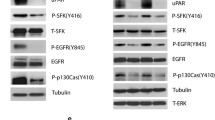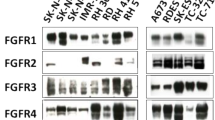Abstract
We previously showed that inhibition of the platelet-derived growth factor receptor (PDGFR) blocks the survival and migration of medulloblastoma cells. Identification of in vitro PDGFR-targeting pharmacologic agents that are suitable for preclinical testing in medulloblastoma models in vivo will be critical for efficiently translating these agents to clinical investigation in children with medulloblastoma. In this study, we investigated whether the multi-tyrosine kinase inhibitor sunitinib, effectively inhibits PDGFR signaling required for medulloblastoma cell migration. Daoy and D556 human medulloblastoma cells pre-treated for 1 h with 0.2 μM sunitinib demonstrated induction of PTEN expression and significant inhibition of PDGFR signaling activity and transactivation of EGFR, in a RAS-independent manner, in response to PDGF-BB stimulation. Sunitinib pre-treatment markedly reduced medulloblastoma cell migration in response to both PDGF-BB and 10% serum at 4 and 24 h after treatment. Pre-treatment with sunitinib for 1 h also resulted in detachment and decreased viability of D556, but not Daoy, cells and only after 48 h following treatment. However, sunitinib did not induce apoptosis in either cell line at any time point, indicating that the anti-migratory effects of sunitinib were not due to impeding cell survival. Sunitinib similarly inhibited PDGFR signaling and migration of primary murine Smo/Smo medulloblastoma cells, suggesting that the Smo/Smo mouse is an appropriate model for preclinical testing of sunitinib. These results indicate that sunitinib may be an important pharmacologic agent for the treatment of invasive medulloblastoma, particularly given evidence of its ability to cross the blood–brain barrier to target tumor cells, and thus warrants further in vivo testing for confirmation of efficacy.







Similar content being viewed by others
References
Giangaspero F, Bigner SH, Kleihues P et al (2000) Medulloblastoma. In: Kleihues P, Cavanee WK (eds) World health organization classification of tumours: pathology and genetics of tumours of the nervous system. International Agency for Research on Cancer, Lyon
McLean TW (2003) Medulloblastomas and central nervous system primitive neuroectodermal tumours. Curr Treat Options Oncol 4:499–508
Packer RJ, Rood BR, Macdonald TJ (2003) Medulloblastoma: present concepts of stratification into risk groups. Pediatr Neurosurg 39:60–67
Abouantoun TJ, MacDonald TJ (2009) Imatinib blocks migration and invasion of medulloblastoma cells by concurrently inhibiting activation of platelet-derived growth factor receptor and transactivation of pf epidermal growth factor receptor. Mol Cancer Ther 8:1137–1147
Koutras AK, Krikelis D, Alexandrou N et al (2007) Brain metastasis in renal cell cancer responding to sunitinib. Anticancer Res 27:4255–4257
Mendel DB, Laird AD, Xin X et al (2003) In vivo antitumor activity of SU11248, a novel tyrosine kinase inhibitor targeting vascular endothelial growth factor and platelet-derived growth factor receptors: determination of a pharmacokinetic/pharmacodynamic relationship. Clin Cancer Res 9:327–337
Motzer RJ, Hutson TE, Tomczak P (2007) SUTENT versus interferon alfa in metastatic renal-cell carcinoma. N Engl J Med 356:115–124
Croyle M, Akeno N, Knauf JA et al (2008) RET/PTC-induced cell growth is mediated in part by epidermal growth factor receptor (EGFR) activation: evidence for molecular and functional interactions between RET and EGFR. Cancer Res 68:4183–4191
Decker SJ, Harris P (1989) Effects of platelet-derived growth factor on phosphorylation of the epidermal growth factor receptor in human skin fibroblast. J Biol Chem 264:9204–9209
Liu P, Ying Y, Ko YG et al (1996) Localization of platelet-derived growth factor-stimulated phosphorylation cascade to caveolae. J Biol Chem 271:10299–10303
Li J, Kim YN, Bertics PJ (2000) Platelet-derived growth factor stimulated migration of murine fibroblasts is associated with epidermal growth factor receptor expression and tyrosine phosphorylation. J Biol Chem 275:2951–2958
He H, Levitzki A, Zhu HJ et al (2001) Platelet-derived growth factor requires epidermal growth factor receptor to activate p21-activated kinase family kinases. J Biol Chem 276:26741–26744
Saito Y, Haendeler J, Hojo Y et al (2001) Receptor heterodimerization: essential mechanism for platelet-derived growth factor-induced epidermal growth factor receptor transactivation. Mol Cell Biol 21:6387–6394
Osusky KL, Hallahan DE, Fu A et al (2004) The receptor tyrosine kinase inhibitor SU11248 impedes endothelial cell migration, tubule formation, and blood vessel formation in vivo, but has little effect on existing tumor vessels. Angiogenesis 7:225–233
De Bouard S, Herlin P, Christensen JG et al (2007) Antiangiogenic and anti-invasive effects of sunitinib on experimental human glioblastoma. Neuro Oncol 9:412–423
Hatton BA, Villavicencio EH, Tsuchiya KD, Pritchard JI et al (2008) The Smo/Smo model: hedgehog-induced medulloblastoma with 90% incidence and leptomeningeal spread. Cancer Res 15:1768–1776
Acknowledgments
Sunitinib was provided by Pfizer Pharma. Supported by NIH R01 grant CA111835 (T.J.M.).
Author information
Authors and Affiliations
Corresponding author
Rights and permissions
About this article
Cite this article
Abouantoun, T.J., Castellino, R.C. & MacDonald, T.J. Sunitinib induces PTEN expression and inhibits PDGFR signaling and migration of medulloblastoma cells. J Neurooncol 101, 215–226 (2011). https://doi.org/10.1007/s11060-010-0259-9
Received:
Accepted:
Published:
Issue Date:
DOI: https://doi.org/10.1007/s11060-010-0259-9




